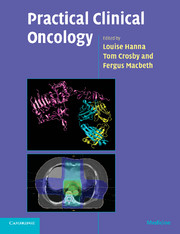Book contents
- Frontmatter
- Contents
- List of contributors
- Preface
- Acknowledgements
- Abbreviations
- 1 Practical issues in cytotoxic chemotherapy usage
- 2 Biological treatments in cancer
- 3 Hormones in cancer
- 4 Radiotherapy planning
- 5 Research in cancer
- 6 Oncological emergencies
- 7 Palliative care
- 8 Head and neck
- 9 Oesophagus
- 10 Stomach
- 11 Liver, gallbladder and biliary tract
- 12 Exocrine pancreas
- 13 Colon and rectum
- 14 Anus
- 15 Gastrointestinal stromal tumours
- 16 Breast
- 17 Kidney
- 18 Bladder
- 19 Prostate
- 20 Testis
- 21 Penis
- 22 Ovary
- 23 Body of the uterus
- 24 Cervix
- 25 Vagina
- 26 Vulva
- 27 Gestational trophoblast tumours
- 28 Lung
- 29 Mesothelioma
- 30 Soft tissue and bone tumours in adults
- 31 The lymphomas and myeloma
- 32 Central nervous system
- 33 Skin cancer other than melanoma
- 34 Melanoma
- 35 Thyroid
- 36 Neuroendocrine tumours
- 37 Cancer in children
- 38 Cancer of unknown primary
- 39 The use of radiotherapy in the treatment of benign conditions
- Multiple choice questions
- Multiple choice answers
- Index
- References
30 - Soft tissue and bone tumours in adults
Published online by Cambridge University Press: 23 December 2009
- Frontmatter
- Contents
- List of contributors
- Preface
- Acknowledgements
- Abbreviations
- 1 Practical issues in cytotoxic chemotherapy usage
- 2 Biological treatments in cancer
- 3 Hormones in cancer
- 4 Radiotherapy planning
- 5 Research in cancer
- 6 Oncological emergencies
- 7 Palliative care
- 8 Head and neck
- 9 Oesophagus
- 10 Stomach
- 11 Liver, gallbladder and biliary tract
- 12 Exocrine pancreas
- 13 Colon and rectum
- 14 Anus
- 15 Gastrointestinal stromal tumours
- 16 Breast
- 17 Kidney
- 18 Bladder
- 19 Prostate
- 20 Testis
- 21 Penis
- 22 Ovary
- 23 Body of the uterus
- 24 Cervix
- 25 Vagina
- 26 Vulva
- 27 Gestational trophoblast tumours
- 28 Lung
- 29 Mesothelioma
- 30 Soft tissue and bone tumours in adults
- 31 The lymphomas and myeloma
- 32 Central nervous system
- 33 Skin cancer other than melanoma
- 34 Melanoma
- 35 Thyroid
- 36 Neuroendocrine tumours
- 37 Cancer in children
- 38 Cancer of unknown primary
- 39 The use of radiotherapy in the treatment of benign conditions
- Multiple choice questions
- Multiple choice answers
- Index
- References
Summary
Introduction
Soft tissue sarcomas are rare. Although there are more than 30 subtypes, the behaviour of most is similar. Tumour size and grade are the best predictors of survival. Surgery is the mainstay of treatment, and adjuvant radiotherapy (RT) is useful for high-risk tumours. The use of adjuvant chemotherapy remains controversial, and metastatic disease responds poorly to doxorubicin and ifosfamide.
The most common bone cancer occurs as a secondary tumour, and the most common primary bone tumours are benign. Primary bone cancers are rare and include those derived from marrow elements, such as myeloma and lymphoma, which are discussed in Chapter 31. Osteosarcoma and Ewing's sarcoma make up the majority of bone sarcomas: they occur most commonly in people in their teens and 20s. Both types of tumour are treated with neoadjuvant and adjuvant ‘sandwich’ chemotherapy and local surgery. The role of RT in osteosarcoma is uncertain, but RT is important in the local control and cure of inoperable Ewing's sarcoma and as an adjunct to marginal surgery. Metastatic disease in both conditions carries a poor prognosis. Rarer bone sarcomas include chondrosarcoma, which responds poorly to either chemotherapy or RT. Other bone sarcomas that show morphological similarity to soft tissue sarcomas are treated in the same way as osteosarcomas. Aneurysmal bone cysts and giant cell tumours are of borderline malignancy.
Sarcomas of the uterus are discussed in Chapter 23 and gastrointestinal stromal tumours are discussed in Chapter 15. Sarcomas in children are discussed in Chapter 37.
- Type
- Chapter
- Information
- Practical Clinical Oncology , pp. 335 - 346Publisher: Cambridge University PressPrint publication year: 2008
References
- 1
- Cited by



